07.26.2012 | 11:23 am
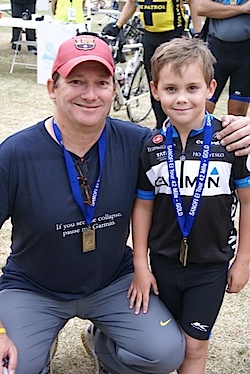 A “Fight Cancer, Win Cool Stuff” Note from Fatty: My friend — and hotshot producer of TNT’s Leverage — Paul Guyot is fundraising for Pedal The Cause. This is a pretty awesome event with 100% of donations being divided between Siteman Cancer Center and St. Louis Children’s Hospital.
A “Fight Cancer, Win Cool Stuff” Note from Fatty: My friend — and hotshot producer of TNT’s Leverage — Paul Guyot is fundraising for Pedal The Cause. This is a pretty awesome event with 100% of donations being divided between Siteman Cancer Center and St. Louis Children’s Hospital.
Paul’s got a great reason to hate cancer and raise money toward the fight against it: both his wife’s parents were killed by cancer last year.
And his son, “Bucky” (he’s the one on the right in the picture here) is joining him in this ride. Which I think is pretty amazing.
Paul’s got some nice incentives you should take a look at, too. And since I’m far too lazy to write about them myself, I’m just going to cut and paste from Paul’s donation page:
Not only will your donation help children and assist in finding a cure for cancer, but you could win some very cool prizes!
For every $10 you donate, you will receive 1 entry into a drawing to win one of the following:
- An actual script from the hit TNT series LEVERAGE autographed by Timothy Hutton and the entire cast!
- ARRIVA LEO Bluetooth Sport wireless headphones! If you don’t know, Arriva Leo’s are AWESOME and endorsed by Fatcyclist.com [Note from Fatty: It’s true — my Leos are at least partially responsible for what is widely regarded as freakishly fast time on a popular MTB climbing TT) as well as thousands of others. Thank you to ARRIVA for donating TWO of these amazing prizes!!!
- A $40 gift card to the restaurant of your choice. ANYWHERE in the United States!
Paul’s a great guy. Cancer sucks. These are awesome prizes. So I highly recommend you go find $10 bucks (or $20 or whatever) and donate now. Thanks!
Considering Options
Earlier this week, I posted about my frustration with Cigna as I’m trying to get the right level of treatment for my son’s depression.
I’ve been trying hard to not let the rage (yes, actual rage, which is weird for a person who is decidedly non-rage-y) dominate me. I even made myself sit down and write a fun post yesterday.
But yesterday afternoon I got a couple calls: one from Cigna, one from the doctor in charge of my son’s treatment. They both were saying essentially the same thing: We had escalated the appeals as high as they escalate, and the answer was the same: no.
So now I need to figure out what to do next. And honestly, I really will not be able to write anything fun or interesting ’til I get this sorted out in my own head, so bear with me.
Option 1: Do What Cigna Says
Cigna says they’ll pay for a reduced level of support — basically about 1/3 of what my son’s doing in the program he’s in now. But the thing is, my son’s really doing well in the program he’s in, and I’m not interested in pulling him out and seeing if he’ll continue to improve if we do less for him. Since this program has seen the first real improvement in his outlook in about five years, I want to stick with it — not swap out to something cheaper and assume that Cigna knows best for my son.
Option 2: Hope HR Pulls Through
The HR department at my company is negotiating with Cigna. I’m not really privy to what they’re doing or how it’s going (though I hope to hear something today).
Option 3: Go Nuclear With Legal
I could hire a lawyer and see whether that would get Cigna’s attention. But even if that resolves the problem for me eventually, it will mean considerable stress and time between now and then. And there’s no guarantee that it will resolve my way, in which case I am now on the hook not just for my son’s treatment but for attorney fees.
I’m not taking this option off the table, but I really hope to avoid it.
Option 4: Pay for Treatment Myself Plus Help from Family
I have a little money saved and a 401K I could raid, and my mom says she could pitch in. Between us, we could pay for my son’s treatment for up to six weeks or so. But I’m really reluctant to raid my mom’s savings (even though she’s been super generous in offering it).
Option 5: Fundraise
My readers have shown, time and time again, how generous they are through the various fundraisers I’ve done. My guess is that if I were to do a contest / fundraiser to cover my son’s treatment, my readers would help me out.
But I don’t like this idea much.
A while back when I decided I could and should use my blog as a soapbox to champion causes I care about, part of the bargain I made with myself was that I would use this to help other people, not to make money for me. And while it could be argued that if I did do such a fundraiser it would be for my son — not me — it’s a slippery slope. I’d rather not get near that slope.
Option 6: Sell Susan’s Novel
Once Susan’s cancer had metastasized and slowed her down so it was hard for her to do much outside, she directed her energy into writing a novel. She got about 95% of it written before the cancer got to her brain and made it so she couldn’t write anymore.
As she worked on writing the book, I promised Susan that if she got it written, I’d get it published. I had a plan on how and where I’d publish this, but maybe this would be a better use.
I am pretty sure that she’d be really pleased to know that the proceeds of her work were dedicated to helping her son.
I like this idea quite a bit. But I don’t know what people will think of reading a novel that ends without an ending.
Option 7: Pre-Sell Fight Like Susan
I’ve been planning to compile the posts about Susan’s fight with cancer, along with commentary and the parts I couldn’t / didn’t write because it was too hard at the time.
I’ve been hoping to have that book finished and ready by the end of the year, but I’ll need money for my son’s treatment before then. If I did pre-orders on the book now for a book that wouldn’t be arriving for several months, would that be a big problem? I don’t know.
I do think Susan would like that the story of her fight eventually helped her son.
I’m sure I haven’t considered all the options. I do know I want to keep my son in the program he’s in; I’m interested in your thoughts on things I’m considering, and ideas for what my next move ought to be.
Comments (114)
07.25.2012 | 12:23 pm
Dear US Forest Service,
First off, I think I might owe you a little apology. See, I’m not exactly sure whether you’re the right people to be sending this letter to. I think it’s probably you, but maybe I should be sending this to the Department of Parks and Recreation.
Or maybe this should be going to the Department of Transportation. That could make sense, unless I should be sending it to the Department of Motor Vehicles.
On the other hand, maybe the State Parks people should be the ones reading this. Or, possibly, the Department of Roadway Design.
Kinda hard to say, honestly. Maybe after you read this letter you’ll do me the favor of sending this on to the people who should be reading it.
If it’s not you, I mean. Which it might be. Possibly.
Climb, Interrupted
Last weekend, The Hammer and I (joined by the IT Guy for the second half of the ride) went on a big ol’ training ride: The Gauntlet Supreme. Starting from home, we ride up American Fork Canyon to Granite Flat, up to the summit of the Alpine Loop, down to Cascade Springs, back up to the summit of the Alpine Loop, down to Provo Canyon, up and down Squaw Peak, up Provo Canyon, up and down South Fork, and then up the Sundance side of the Alpine loop and down the AF side, and — finally! — back to home.
Here’s what it looks like on a map:
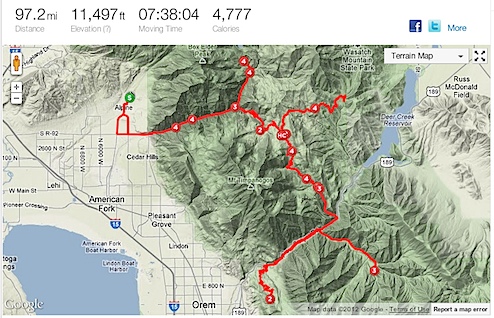
It kinda looks like a man holding a bell, doesn’t it? At least a little bit?
Along the way, there’s a fair amount of climbing. And descending. Indeed, since we wind up where we started the ride, I believe it could be said that the amount of climbing and descending are practically identical. Here’s what it looks like:

That’s a pretty jagged-looking elevation chart. Which is fine. We signed up for all that climbing, so we aren’t going to complain about it.
No, just kidding. Actually almost the whole rest of this letter is going to be complaining. So you might want to brace yourself for that.
See, there’s one particular part of this ride that just seems . . . well, wrong: The Cascade Spring climb.
No, the problem isn’t with the scenery; the scenery is gorgeous. The problem isn’t with traffic; since this seven-mile road goes nowhere but to a small (but beautiful and well-worth seeing in its own right) park, there’s rarely any traffic at all. The problem isn’t even with the pavement; there are some cracks with weeds growing through, but they aren’t really a problem.
The problem is with the elevation profile.
As a refresher, take a look at what this seven-mile climb looks like, elevation-wise:

On second thought, that elevation profile isn’t very dramatic; it certainly doesn’t reflect the steepness I feel when I climb that sucker. Instead, take a look at mile 28 -35 from this closeup of the elevation chart for the whole ride we did:
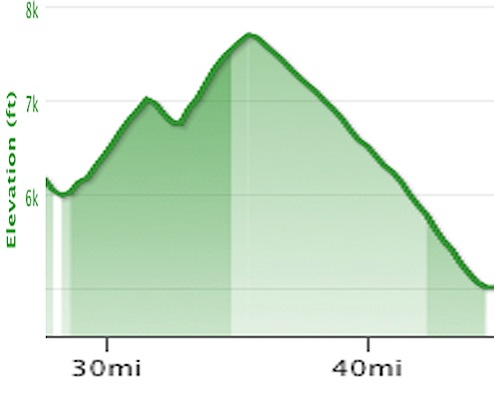
Do you see the problem now?
You don’t?
Well, that’s because you don’t ride a bike, US Forest Service (or whoever). Which is understandable, I guess, because it would be weird to see the US Forest Service on a bike. And probably very uncomfortable for you.
I’m getting sidetracked. Let me get back to my point.
The problem with the Cascade Springs Climb is that it has a nice one-mile descent, right in the middle of the climb. The result being that you climb three miles, descend one mile, and then climb three more miles to get to the summit.
“I fail to see the problem,” I can imagine you saying, US Forest Service (or etc.). “You should be thanking us! We gave you a nice little break in the middle of a very difficult climb — in fact, that break comes right before the hardest part of the climb. We’ve given you the opportunity to rest up before beginning the second three miles of climbing.”
And that just goes to show, US Forest Service, that you don’t understand what is going on in the mind of cyclists when we are doing a big climb.
Allow me to clear that up, for your future reference.
The Problem With Short Descents Between Big Climbs
See, when cyclists start big, long climbs, we steel ourselves for what is to come. “Seven miles of climbing,” we tell ourselves. “We’re going to grind it out, grit our teeth, grind it out, weave all over the place, and otherwise haul ourselves up this road ’til we get to the top.”
And we do it. We bribe ourselves, lie to ourselves, convince ourselves, argue with ourselves, and otherwise hold internal dialogues that would frighten priests and psychiatrists alike. Whatever it takes to keep the legs turning until we get to the top.
But just suppose that right in the middle of this dramatic and traumatic and superhuman effort, the climb ends?
And instead of climbing and suffering and gnashing our teeth, we are coasting effortlessly downhill?
The storm of emotions is just too much to take.
First, there’s elation: “Wheee! I no longer hurt! And instead of 4.8mph, I’m going thirty! I am so happy!”
But then there’s distress: “This descent ends in just one mile. At 30mph, that’s just two minutes before I have to climb again. I don’t want to start climbing again in two minutes. I don’t want to start climbing again at all.
And then, finally, there’s the horror at the dawn of understanding: “Wait a second. By having a descent in the middle of a climb, I’m effectively having to re-climb altitude that I have already earned.”
It is at this moment that the weeping usually begins.
For while cyclists are — for some reason — OK with earning a big chunk of altitude all at once, it is with the expectation that we will get to spend it all at once, as well. Here, instead, we descend just long enough for our legs to fall out of the rhythm of climbing. To let the lactic acid pool up. To realize, fully and completely, that we’re tired.
And then we have to start climbing again. Climbing up to a height we already climbed up, just a couple minutes ago.
Whimpering and complaining is not only common, it’s expected.
Solutions
US Forest Service (…), I am not the kind of person who identifies a problem without suggesting solutions. I have two excellent ideas, either of which I believe can be executed with a minimum of expense and effort.
Idea 1: Bridge: My first idea would be the simplest and most straightforward to execute: simply build a cycling bridge, spanning the beginning of the descent to the equivalent spot in altitude a couple miles down (and then up) the road:
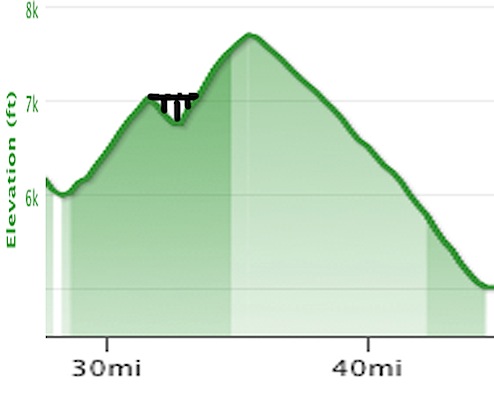
I think the benefits of doing this are as obvious as they are compelling. First, cyclists (i.e., me) still get a nice little break from the climbing — when you’ve been climbing hard, flat really does feel like downhill. Second, finishing times for this climb would shrink drastically, causing cyclists to feel much better about themselves and their state of fitness without having to resort to ridiculous measures like doping or training more.
Further, I believe that if you build this bridge you’ll bring curious people from all over the world to see this two-mile wonder. Certainly, the surge of tourist dollars will more than offset the minor costs you might incur by building this bridge.
One last note regarding this bridge: I think you should make it out of carbon fiber. It’s both strong and light.
Idea 2: Redistribution: While I believe my first idea is a good one, I must be honest with myself and admit that it is really nothing more than a half-measure. To really and truly fix the problem, you’re going to need a big shovel.
A really big shovel:

Where the “bridge” idea simply eliminates redundant climbing on this road, filling in the unneccessary descent and subsequent climb with what was previously the top of the mountain actually reduces the total amount of climbing required.
Consider: Right now cyclists must make a thousand-foot climb, descend 300 feet, and then make a 1200 foot climb. That’s 2200 feet of climbing. With my “Repurpose the Mountain Summit” plan, however, we’ll climb up a thousand feet or so, catch our breath on the two-mile flat section, and then make a 500 foot climbing push to the new, lower, and flatter summit.
That’s 1500 feet of climbing — a savings of 700 feet.
Honestly, I don’t even think I need to explain how perfect an idea this is. In fact, I am currently agog at my own brilliance.
US Forest etc., I believe I have presented a compelling case; I can see no reason why you would not begin work on this immediately, even at the expense of in-progress projects. This is that important.
I look forward to climbing the new and (drastically) improved Cascade Spring climb.
Kind Regards,

The Fat Cyclist
Comments (44)
07.23.2012 | 1:54 pm
This is the time of year when I have the best ideas for blog entries. I’m on my bike a lot, and as I ride, funny and interesting thoughts seem to just occur to me, usually a couple of them per ride. The biggest challenge I have is remembering all the ideas long enough after the ride that I can jot them down to do the post on later.
I currently have a backlog of 18 post ideas; it makes sitting down and actually writing this blog so easy, because instead of the “what should I write about today?” question, I get to choose which idea I want to write about.
So this morning I sat down and started doing the Photoshop work for the post I wanted to write (illustrations were necessary for this idea).
And that’s when I got the call from Cigna, the insurance company my employer uses.
Cigna says that as of today, they will no longer cover the program my son is in to help with his severe depression.
And obviously I am no longer in a mood to write anything funny at all.
A Little About Depression
Depression comes hand in hand with cancer. One of the things I haven’t talked about in this blog (but will in my Fight Like Susan book) is the depression Susan had to battle after she finished treatment the first time she had cancer.
It was around that time that my son started showing signs of depression, too.
Now, many years — and doctor visits and therapists and psychiatrists — later, he’s still fighting depression, which has only become worse, to the point that it is essentially debilitating.
A Program That Works
But I recently found a program that was helping. A comprehensive program, with academic, therapeutic, and psychiatric aspects combined. For the past two weeks, he’s been there eight hours a day, five days a week.
His progress hasn’t been fast — you don’t overcome depression fast — but it has been progress, for the first time, ever.
And that’s where the phone call from Cigna comes in. They believe he doesn’t need this level of treatment. It isn’t medically necessary. Visits to a psychiatrist and maybe a counsellor should be sufficient.
Right, because that’s been so successful so far.
No Help
Today we did what is called an “expedited appeal,” which is where the doctor that’s working with my son talks with one of Cigna’s doctors and tries to convince the Cigna doctor that my son actually needs the help he’s getting — that it’s not just for entertainment or free babysitting or whatever.
The Cigna doctor turned down the doctor caring for my son immediately and easily, saying that since my son is not in “imminent danger” — he is not actively attempting to kill himself — this level of care is unnecessary. A weekly visit to his therapist should do the trick.
Right.
Please Help
So now we’re at the next level of appeal. The doctor caring for Brice isn’t particularly hopeful; Cigna seems to be pretty comfortable with the word “no.”
After that, I have to start looking at other options. Raiding my 401K. Asking parents for money. Telling my son I’m sorry, but he’ll just have to soldier on as best as he can. After all, it’s not like depression is a real disease, and it’s not like he has cause, right? Buck up, kid.
OK, that last sentence started letting the anger and bitterness out a little bit more than I wanted. I’m going to leave it in there just so you can see what I’m trying to hold back here.
So, maybe you can help. Maybe you work at Cigna, or know someone who does. Or maybe you might want to email them or tweet something to @Cigna and @Cignaquestions.
I don’t know if any of that will help. I really don’t. Maybe it will even make things worse for me.
But this is my son.
And this is what Cigna is supposed to do.
And they’re not doing it.
Comments (104)
07.23.2012 | 10:30 am
I had an idea for a funny post.
Then I got a call that made the idea of writing something funny impossible.
So I wrote an angry post.
Then I talked with a person I trust at work who said maybe I should hold up on publishing that angry post, because gears are in motion and maybe my angry post would stop those gears.
So I’m holding fire, for now.
But there’s still no way I could write anything funny right now. It’s been years and years since I’ve been so angry.
I’ll write again when I can. Not sure when.
PS: For those of you who follow me on Twitter, yes, it’s about this and this.
Comments (27)
07.20.2012 | 7:00 am
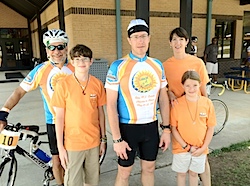 A Note from Fatty: Today’s Free Verse Friday poem was sent in by Tim Kalafut (pictured in the center of this picture with his family).
A Note from Fatty: Today’s Free Verse Friday poem was sent in by Tim Kalafut (pictured in the center of this picture with his family).
Like, he sent it back in May. As a testament to it’s memorableness, I remembered it all the way ’til now.
It isn’t just art. It’s truth. And it’s pretty funny (because it’s true), too.
Thus, I am pleased to present the first guest Free Verse Friday submission, which is aptly titled:
Ode to 17mph
An Epic Free Form Poem (Iambic Pentameter Is Way Too Hard)
by Tim Kalafut
I have a nifty bike
With a computer that I like.
It tracks my average speed,
And lots more data than I need.
But it seems no matter what I do
I hate to say it, but it’s true –
When I ride, I average 17 miles per hour.
(Plus or minus 0.5)
I can ride for 15 miles in the evening after work.
Or, 105 miles in a day to Fight MS!
I ride 17 mph. (Average, ±0.5)
I can take “performance enhancing pharmaceuticals.”
Or, not.
(I would fail a pee test right now in the TdF
As my #1-guard-on-the-clipper haircut combined with
Too much time in the bike helmet has resulted in
“Folliculitis of the scalp” and my wife is repulsed
By the top of my head, so the doc gave me a
Corticosteroid shampoo.
She hasn’t noticed any performance benefits.
Nor has the bike computer.)
I ride 17 mph. (Average, ±0.5)
I can ride on fancy wheels –
$1500 super light weight climbers,
$2500 borrowed fancy aero wheels.
Or, I can ride on the $100 flexible cast iron hoops the bike came with.
I ride 17 mph. (Average, ±0.5)
I can “taper” my training to prepare my body
To be in perfect condition for a given ride.
Or, I can run in a 5K race in the morning
Wherein I pull a calf muscle and limp the last 2.5 miles
And then ride 54 miles later that day.
I ride 17 mph. (Average, ±0.5)
I can ride solo, accompanied only by my thoughts.
Or, with studly fitness types that are 15 years younger than me.
(I’m talking about you, David and Phil and Mike)
I ride 17 mph. (Average, ±0.5)
I can ride in the drops and use the big ring.
Or, I can sit up using the hoods
(Or even rest my hands the top of the handle bar!)
And pedal along all nice and relaxed in the small ring.
I ride 17 mph. (Average, ±0.5)
I can consume exotic nutritional supplements –
Like “gels” and “gus” and “power bars” and “shot blocks.”
Or, I can ride fueled only by the fat stored in my spare tire.
(Be careful of Stinger Waffles. Bike food crack.)
I ride 17 mph. (Average, ±0.5)
I can stand up and attack the hills.
Or, I can sit and spin my way up in an easy gear.
I ride 17 mph. (Average, ±0.5)
I can use “chamois butter.”
Or, ride dry.
(Don’t ask for an explanation if you don’t know.)
I ride 17 mph. (Average, ±0.5)
The temperature can be in the 40’s and I’m
Wearing two pairs of gloves, shoe covers, helmet liners, tights,
And three layers on my torso.
Or, it can be in the 90’s and I’m
Wearing the thinnest jersey I can find
And dumping water down it to stay cool.
I ride 17 mph. (Average, ±0.5)
I can ride my normal rolling terrain.
Or, I can climb 1500 feet in 4 miles,
Followed by glorious 30+ mph
Screaming downhill descents without
A single pedal stroke for that same distance.
I ride 17 mph. (Average, ±0.5)
I can be 170 pounds where you can see – Hey! –
I actually have muscles in my shoulders and veins in my arms!
Or, I can be 185 pounds and look as spongy as the Pillsbury Doughboy.
I ride 17 mph. (Average, ±0.5)
I can take breaks every 15-20 miles,
And even stop for lunch.? Or, I can ride 40-50 miles straight
And never unclip to touch a toe to the ground a single time.
I ride 17 mph. (Average, ±0.5)
It can be breezy enough to turn every flag I pass into a windsock
Suitable for landing light aircraft.
Or, so hot and humid and still that my glasses fog up every time I stop.
I ride 17 mph. (Average, ±0.5)
I can do “proper carb loading” a few days ahead of time,
Or, I can stuff myself with BBQ and beer the night before.
I ride 17 mph. (Average, ±0.5)
My legs can be smoothly shaved, perfectly tanned,
And clad in the latest fashion cycling socks.
Or, my legs can be all hairy and wearing old running socks
With holes in the toes.
I ride 17 mph. (Average, ±0.5)
I can pedal at a theoretically perfect 90 rpm for miles at a time
In the perfect gear for every situation.
Or, I can mash the pedals at 60 rpm in the big ring
With bursts to 110 rpm in small gears as I fade on the hills.
I ride 17 mph. (Average, ±0.5)
I can set out to do a super intense,
Feel-the-burn, intervals-that-make-you-want-to-puke
Workout with a max heart rate
Fit only for an 18 year old middle distance track star.
Or, I can enjoy the scenery
And leave the heart rate strap at home,
Riding just to clear my head.
I ride 17 mph. (Average, ±0.5)
I don’t know if 17 mph is slow or fast.
Or, whether it’s good for first or last.
But if you’re out and about
And ever happen to see
Someone averaging 17 (±0.5)
Say “Hi” –
It’s probably me.
Comments (30)
« Previous Page — « Previous Entries Next Entries » — Next Page »
 A “Fight Cancer, Win Cool Stuff” Note from Fatty: My friend — and hotshot producer of TNT’s Leverage — Paul Guyot is fundraising for Pedal The Cause. This is a pretty awesome event with 100% of donations being divided between Siteman Cancer Center and St. Louis Children’s Hospital.
A “Fight Cancer, Win Cool Stuff” Note from Fatty: My friend — and hotshot producer of TNT’s Leverage — Paul Guyot is fundraising for Pedal The Cause. This is a pretty awesome event with 100% of donations being divided between Siteman Cancer Center and St. Louis Children’s Hospital.







